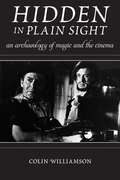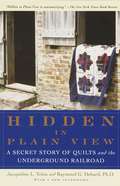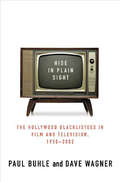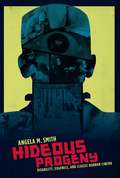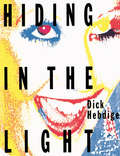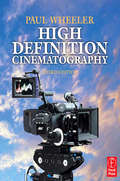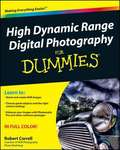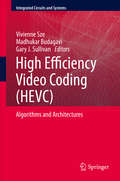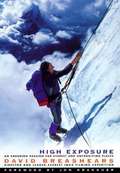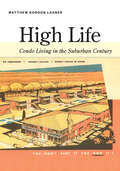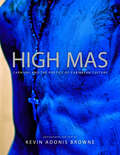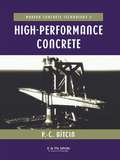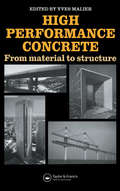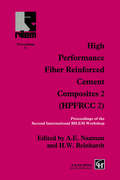- Table View
- List View
Hidden in Plain Sight
by Colin WilliamsonWhat does it mean to describe cinematic effects as "movie magic," to compare filmmakers to magicians, or to say that the cinema is all a "trick"? The heyday of stage illusionism was over a century ago, so why do such performances still serve as a key reference point for understanding filmmaking, especially now that so much of the cinema rests on the use of computers? To answer these questions, Colin Williamson situates film within a long tradition of magical practices that combine art and science, involve deception and discovery, and evoke two forms of wonder--both awe at the illusion displayed and curiosity about how it was performed. He thus considers how, even as they mystify audiences, cinematic illusions also inspire them to learn more about the technologies and techniques behind moving images. Tracing the overlaps between the worlds of magic and filmmaking, Hidden in Plain Sight examines how professional illusionists and their tricks have been represented onscreen, while also considering stage magicians who have stepped behind the camera, from Georges Méliès to Ricky Jay. Williamson offers an insightful, wide-ranging investigation of how the cinema has functioned as a "device of wonder" for more than a century, while also exploring how several key filmmakers, from Orson Welles to Christopher Nolan and Martin Scorsese, employ the rhetoric of magic. Examining pre-cinematic visual culture, animation, nonfiction film, and the digital trickery of today's CGI spectacles, Hidden in Plain Sight provides an eye-opening look at the powerful ways that magic has shaped our modes of perception and our experiences of the cinema.
Hidden in Plain Sight (Mystery of Eckert House #1)
by Chris AuerEerie stories surround the old Victorian mansion-turned-museum known as Eckert House. But what was once thought to be fiction may prove to be fact after twelve-year-old Dan Pruitt makes a gruesome discovery. Dan and his friends set out to uncover the truth, but will their search lead them down a path of danger instead?
Hidden in Plain View: A Secret Story of Quilts and the Underground Railroad
by Jacqueline L. Tobin Raymond G. DobardThe fascinating story of a friendship, a lost tradition, and an incredible discovery, revealing how enslaved men and women made encoded quilts and then used them to navigate their escape on the Underground Railroad. In Hidden in Plain View, historian Jacqueline Tobin and scholar Raymond Dobard offer the first proof that certain quilt patterns, including a prominent one called the Charleston Code, were, in fact, essential tools for escape along the Underground Railroad. In 1993, historian Jacqueline Tobin met African American quilter Ozella Williams amid piles of beautiful handmade quilts in the Old Market Building of Charleston, South Carolina. With the admonition to "write this down," Williams began to describe how slaves made coded quilts and used them to navigate their escape on the Underground Railroad. But just as quickly as she started, Williams stopped, informing Tobin that she would learn the rest when she was "ready." During the three years it took for Williams's narrative to unfold—and as the friendship and trust between the two women grew—Tobin enlisted Raymond Dobard, Ph.D., an art history professor and well-known African American quilter, to help unravel the mystery.Part adventure and part history, Hidden in Plain View traces the origin of the Charleston Code from Africa to the Carolinas, from the low-country island Gullah peoples to free blacks living in the cities of the North, and shows how three people from completely different backgrounds pieced together one amazing American story.With a new afterword. Illlustrations and photographs throughout, including a full-color photo insert.
Hide in Plain Sight
by Paul Buhle Dave WagnerHide in Plain Sight completes Buhle and Wagner's trilogy on the Hollywood blacklist. When the blacklistees were hounded out of Hollywood, some left for television where many worked on children's shows like "Rocky and Bullwinkle." A number wrote adult sitcoms such as The Donna Reed Show, and M*A*S*H while some of them ultimately returned to Hollywood and made great films such as Norma Rae, and Midnight Cowboy. This is a thoughtful look at the rising fear of communism in America and the aftermath of the horror that was the McCarthy period, from two expert historians of the blacklist period.
Hideous Progeny: Disability, Eugenics, and Classic Horror Cinema
by Angela M. SmithTwisted bodies, deformed faces, aberrant behavior, and abnormal desires characterized the hideous creatures of classic Hollywood horror, which thrilled audiences with their sheer grotesqueness. Most critics have interpreted such traits as symptoms of sexual repression, or as metaphors for other kinds of marginalized identities, but Angela M. Smith conducts a richer investigation into the period's social and cultural preoccupations. Presenting an altogether different reading, she finds in the narrative and spectacle of classic 1930s horror a fascination with eugenics and physical and cognitive debility, heightened by viewers' own desire for visions of vulnerability and transformation.
Hideous Progeny: Disability, Eugenics, and Classic Horror Cinema (Film and Culture Series)
by Angela SmithTwisted bodies, deformed faces, aberrant behavior, and abnormal desires characterized the hideous creatures of classic Hollywood horror, which thrilled audiences with their sheer grotesqueness. Most critics have interpreted these traits as symptoms of sexual repression or as metaphors for other kinds of marginalized identities, yet Angela M. Smith conducts a richer investigation into the period's social and cultural preoccupations. She finds instead a fascination with eugenics and physical and cognitive debility in the narrative and spectacle of classic 1930s horror, heightened by the viewer's desire for visions of vulnerability and transformation. Reading such films as Dracula (1931), Frankenstein (1931), Dr. Jekyll and Mr. Hyde (1931), Freaks (1932), and Mad Love (1935) against early-twentieth-century disability discourse and propaganda on racial and biological purity, Smith showcases classic horror's dependence on the narratives of eugenics and physiognomics. She also notes the genre's conflicted and often contradictory visualizations. Smith ultimately locates an indictment of biological determinism in filmmakers' visceral treatments, which take the impossibility of racial improvement and bodily perfection to sensationalistic heights. Playing up the artifice and conventions of disabled monsters, filmmakers exploited the fears and yearnings of their audience, accentuating both the perversity of the medical and scientific gaze and the debilitating experience of watching horror. Classic horror films therefore encourage empathy with the disabled monster, offering captive viewers an unsettling encounter with their own impairment. Smith's work profoundly advances cinema and disability studies, in addition to general histories concerning the construction of social and political attitudes toward the Other.
Hiding Making - Showing Creation: The Studio from Turner to Tacita Dean
by Rachel Esner Sandra Kisters Ann-Sophie LehmannThe artist, at least according to Honoré de Balzac, is at work when he seems to be at rest; his labor is not labor but repose. This observation provides a model for modern artists and their relationship to both their place of work-the studio-and what they do there. Examining the complex relationship between process, product, artistic identity, and the artist's studio-in all its various manifestations-the contributors to this volume consider the dichotomy between conceptual and material aspects of art production. The various essays also explore the studio as a form of inspiration, meaning, function, and medium, from the nineteenth century up to the present.
Hiding in the Light: On Images and Things (Comedia)
by Dick HebdigeDick Hebdige looks at the creation and consumption of objects and images as diverse as fashion and documentary photographs, 1950's streamlined cars, Italian motor scooters, 1980's 'style manuals', Biff cartoons, the Band Aid campaign, Pop Art and promotional music videos. He assesses their broad cultural significance and charts their impact on contemporary popular tastes.
Hierarchy, Information and Power: Cities as Corporate Command and Control Centers
by Hongmian GongThis book is a collection of selected papers presented in the 2012 annual meeting of the Association of American Geographers in New York honoring James O. Wheeler (1938-2010). The eight papers are informed and inspired by James O. Wheeler's many contributions to urban geography, particularly in the areas of urban hierarchy, information flows, cities in the telecommunications age, and cities as corporate command and control centers. They adopt and extend Jim Wheeler’s corporate and/or hierarchical approaches to discuss institutional investment in the U.S., corporate interlocking directorates and fast-growing firms in Canada, corporate intangible assets in South Korea, urban development in Beijing and Macau, and social and cultural diversity of global cities such as New York. Although these two approaches are not the fanciest ones in today's urban geography, they are essential to the understanding of how urban areas are connected and what drives this interconnectedness in this age of globalization. This book was previously published as a special issue of Urban Geography.
High Art: The Definitive Guide to Getting Cultured with Cannabis
by Robert Lambrechts Estefanio HoltzArt can be confusing. Luckily, there&’s marijuana. This book pairs fifty classic works from all around the world with unique cannabis recommendations. High Art gives you answers to questions that have long plagued art history students, such as Is there an edible that will help me understand Cubism? (Yes!) Can a cannabis strain connect me more deeply to late-period Van Gogh? (Of course!) And Should I be intimidated by the work of William Blake? (Very much so—but cannabis extracts can help.)To get in touch with your inner self while viewing Van Gogh&’s Self-Portrait with a Straw Hat, toke on some of Gravita&’s Red-Headed Stranger and really feel the brush strokes wash over you. Or while viewing Henri Rousseau&’s 1910 Tropical Forest with Monkeys, you might smoke some mild Purple Monkey followed by a snack of THC-infused dried fruits for a body float that will allow you to connect with your primitive nature.So whether you know a lot about art and nothing about cannabis or a lot about cannabis and nothing about art, it&’s high time you expanded your mind.
High Bridge (Postcard History)
by William Honachefsky Jr.The history of High Bridge is intertwined with the development of the iron and steel industry in the United States. As early as the 1700s, the framework of this little hamlet had already been created by English investors who carved up the rich wilderness of the New World, brimming with iron ore that would be essential to the county's development. High Bridge Borough evolved around the Taylor Wharton Foundry, established in 1742. With the passage of time, however, High Bridge has lost its farming and foundry roots, evolving into what is often referred to as a bedroom community. Just like the lofty trestle from which High Bridge derived its name, the city now runs the risk of being lost to time, forsaking the resilient character of the immigrants who forged a nation. This book aims to preserve High Bridge's glorious history for future generations.
High Contrast: Race and Gender in Contemporary Hollywood Films
by Sharon WillisIn High Contrast, Sharon Willis examines the dynamic relationships between racial and sexual difference in Hollywood film from the 1980s and 1990s. Seizing on the way these differences are accentuated, sensationalized, and eroticized on screen--most often with little apparent regard for the political context in which they operate--Willis restores that context through close readings of a range of movies from cinematic blockbusters to the work of the new auteurs, Spike Lee, David Lynch, and Quentin Tarantino.Capturing the political complexity of these films, Willis argues that race, gender, and sexuality, as they are figured in the fantasy of popular film, do not function separately, but rather inform and determine each other's meaning. She demonstrates how collective anxieties regarding social difference are mapped onto big budget movies like the Die Hard and Lethal Weapon series, Basic Instinct, Fatal Attraction, Thelma and Louise, Terminator 2, and others. Analyzing the artistic styles of directors Lynch, Tarantino, and Lee, in such films as Wild at Heart, Pulp Fiction, and Do the Right Thing, she investigates how these interactions of difference are linked to the production of specific authorial styles, and how race functions for each of these directors, particularly in relation to gender identity, erotics, and fantasy.
High Cost of Free Parking
by Donald ShoupOff-street parking requirements are devastating American cities. So says the author in this no-holds-barred treatise on the way parking should be. Free parking, the author argues, has contributed to auto dependence, rapid urban sprawl, extravagant energy use, and a host of other problems. Planners mandate free parking to alleviate congestion, but end up distorting transportation choices, debasing urban design, damaging the economy, and degrading the environment. Ubiquitous free parking helps explain why our cities sprawl on a scale fit more for cars than for people, and why American motor vehicles now consume one-eighth of the world's total oil production. But it doesn't have to be this way. The author proposes new ways for cities to regulate parking, namely, charge fair market prices for curb parking, use the resulting revenue to pay for services in the neighborhoods that generate it, and remove zoning requirements for off-street parking.
High Definition Cinematography
by Paul WheelerHigh-definition is now ubiquitous in video production and High Definition Cinematography, Third Edition provides the explanations, definitions, and workflows that today's cinematographers and camera operators need to make the transition. Paul Wheeler will explain the high-definition process, suggest the best methods for filming, and help you choose the right camera and equipment for your crew with this comprehensive book. You'll also learn the different formats and when best to use them, how to create specific looks for different venues, and learn how to operate a wide variety of popular cameras.
High Definition Postproduction: Editing and Delivering HD Video
by Steven E. Browne* Real-world postproduction paths show how it's being done today * Numerous HD tables clear up what format is used for which purpose * Ample information on HDV * Debunks myths and answers common questions about HDAvoid costly missteps in postproduction and get it right the first time with this book. Written by an in-the-trenches professional who works with HD every day, High Definition Postproduction is an overview of this exciting opportunity for film and video production and postproduction professionals. High Definition production and editing is here and definitely a reality. High-def network shows are aired on a weekly basis. Several HD-only channels are well into their production schedules. HD is even used for major film productions and post production processes. However, unlike the existing 4x3, NTSC format, the HD world has many variables. This ability to choose various frame rates, frame sizes, bit rates, and color space options makes this an exciting, yet somewhat daunting challenge. The future may hold even more options as electronics continue to evolve and manufactures continue to exploit this format. Naturally, all of these options can lead to confusion and errors. This book begins with an overview of the HD format and then covers commonly-asked questions. A chapter on shooting details how to smooth the path for post. Postproduction workflows, including the digital intermediate, are covered in great detail, and are enhanced by real-world examples. From HDV to the high-end cameras used in Star Wars and Sin City, this book is your complete guide to HD.
High Dynamic Range Digital Photography For Dummies
by Robert CorrellCreate amazing HDR photos with this full-color, plain-English guide Your secret is safe with us. Even if you don't have the latest high-end high dynamic range (HDR) camera equipment, you can still create striking images that appear as if you do with the tips, tricks, and techniques in this helpful guide. Discover how to use bracketing effectively, get the most out of a tripod, finesse your photos with Photoshop, and make it all go easier with this practical and inspiring book. Shines a light on HDR-what it is, how it's done, and what tools you need Walks you through how to take good photographs, from using the right settings to choosing good HDR subjects Demonstrates how to put all your images together in a single photo, including selecting the software, establishing workflow, and creating files Covers how you can clean up digital residue, how to create HDR in black and white, and much more Packed with beautiful and inspiring full-color HDR images to fire your imagination Get fresh ideas, avoid mistakes, and produce memorable images with this essential guide.
High Efficiency Video Coding (HEVC)
by Vivienne Sze Madhukar Budagavi Gary J. SullivanThis book provides developers, engineers, researchers and students with detailed knowledge about the High Efficiency Video Coding (HEVC) standard. HEVC is the successor to the widely successful H. 264/AVC video compression standard, and it provides around twice as much compression as H. 264/AVC for the same level of quality. The applications for HEVC will not only cover the space of the well-known current uses and capabilities of digital video - they will also include the deployment of new services and the delivery of enhanced video quality, such as ultra-high-definition television (UHDTV) and video with higher dynamic range, wider range of representable color, and greater representation precision than what is typically found today. HEVC is the next major generation of video coding design - a flexible, reliable and robust solution that will support the next decade of video applications and ease the burden of video on world-wide network traffic. This book provides a detailed explanation of the various parts of the standard, insight into how it was developed, and in-depth discussion of algorithms and architectures for its implementation.
High Exposure: An Enduring Passion for Everest and Unforgiving Places
by Jon Krakauer David F. BreashearsFor generations of resolute adventurers, from George Mallory to Sir Edmund Hillary, Tenzing Norgay to Jon Krakauer, Mount Everest and the world's greatest peaks have provided the ultimate testing ground. As the world's fascination with mountaineering reaches a fever pitch, the question remains: Why climb? In High Exposure, elite mountaineer and acclaimed filmmaker David Breashears answers with an intimate and captivating look at his life. Breashears's passion for climbing began on the cliffs of Boulder, Colorado--and nearly ended on the south side of Everest in 1996.
High Life: Condo Living in the Suburban Century
by Matthew LasnerThe first comprehensive architectural and cultural history of condominium and cooperative housing in twentieth-century America. Today, one in five homeowners in American cities and suburbs lives in a multifamily home rather than a single-family house. As the American dream evolves, precipitated by rising real estate prices and a renewed interest in urban living, many predict that condos will become the predominant form of housing in the twenty-first century. In this unprecedented study, Matthew Gordon Lasner explores the history of co-owned multifamily housing in the United States, from New York City’s first co-op, in 1881, to contemporary condominium and townhouse complexes coast to coast. Lasner explains the complicated social, economic, and political factors that have increased demand for this way of living, situating the trend within the larger housing market and broad shifts in residential architecture and family life. He contrasts the prevalence and popularity of condos, townhouses, and other privately governed communities with their ambiguous economic, legal, and social standing, as well as their striking absence from urban and architectural history.
High Mas: Carnival and the Poetics of Caribbean Culture
by Kevin Adonis BrowneOverall Winner of the 2019 OCM Bocas Prize for Caribbean LiteratureHigh Mas: Carnival and the Poetics of Caribbean Culture explores Caribbean identity through photography, criticism, and personal narrative. Taking a sophisticated and unapologetically subjective Caribbean point of view, the author delves into Mas—a key feature of Trinidad performance—as an emancipatory practice. The photographs and essays here immerse the viewer in carnival experience as never before. Kevin Adonis Browne divulges how performers are or wish to be perceived, along with how, as the photographer, he is implicated in that dynamic. The resulting interplay encourages an informed, nuanced approach to the imaging of contemporary Caribbeanness. The first series, “Seeing Blue,” features Blue Devils from the village of Paramin, whose performances signify an important revision of the post-emancipation tradition of Jab Molassie (Molasses Devil) in Trinidad. The second series, “La Femme des Revenants,” chronicles the debut performance of Tracey Sankar’s La Diablesse, which reintroduced the “Caribbean femme fatale” to a new audience. The third series, “Moko Jumbies of the South,” looks at Stephanie Kanhai and Jonadiah Gonzales, a pair of stilt-walkers from the performance group Touch de Sky from San Fernando in southern Trinidad. “Jouvay Reprised,” the fourth series, follows the political activist group Jouvay Ayiti performing a Mas in the streets of Port of Spain on Emancipation Day in 2015. Troubling the borders that persist between performer and audience, embodiment and spirituality, culture and self-consciousness, the book interrogates what audiences understand about the role of the participant-observer in public contexts. Representing the uneasy embrace of tradition in Trinidad and the Caribbean at large, the book probes the multiple dimensions of vernacular experience and their complementary cultural expressions. For Browne, Mas performance is an exquisite refusal to fully submit to the lingering traumas of slavery, the tyrannies of colonialism, and the myths of independence.
High Performance Concrete
by Pierre-Claude AïtcinA complete review of the fast-developing topic of high performance concrete (HPC) by one of the leading researchers in the field. It covers all aspects of HPC from materials, properties and technology, to construction and testing. The book will be valuable for all concrete technologists and construction engineers wishing to take advantage of the re
High Performance Concrete: From material to structure
by Yves MalierProvides a thorough review of properties, durability and use of high performance concrete, derived from recent research and experience. This book contains contributions from the leading French, Canadian and Swiss researchers, designers and material specialists, translated into English for the first time.
High Performance Fiber Reinforced Cement Composites 2: Proceedings of the International Workshop
by H. W. Reinhardt A. E. NaamanThe leading international authorities bring together in this contributed volume the latest research and current thinking on advanced fiber reinforced cement composites. Under rigorous editorial control, 13 chapters map out the key properties and behaviour of these materials, which promise to extend their applications into many more areas in the com
High Performance Linux Clusters with OSCAR, Rocks, OpenMosix, and MPI: A Comprehensive Getting-Started Guide
by Joseph D SloanTo the outside world, a "supercomputer" appears to be a single system. In fact, it's a cluster of computers that share a local area network and have the ability to work together on a single problem as a team. Many businesses used to consider supercomputing beyond the reach of their budgets, but new Linux applications have made high-performance clusters more affordable than ever. These days, the promise of low-cost supercomputing is one of the main reasons many businesses choose Linux over other operating systems.This new guide covers everything a newcomer to clustering will need to plan, build, and deploy a high-performance Linux cluster. The book focuses on clustering for high-performance computation, although much of its information also applies to clustering for high-availability (failover and disaster recovery). The book discusses the key tools you'll need to get started, including good practices to use while exploring the tools and growing a system. You'll learn about planning, hardware choices, bulk installation of Linux on multiple systems, and other basic considerations. Then, you'll learn about software options that can save you hours--or even weeks--of deployment time.Since a wide variety of options exist in each area of clustering software, the author discusses the pros and cons of the major free software projects and chooses those that are most likely to be helpful to new cluster administrators and programmers. A few of the projects introduced in the book include:MPI, the most popular programming library for clusters. This book offers simple but realistic introductory examples along with some pointers for advanced use.OSCAR and Rocks, two comprehensive installation and administrative systemsopenMosix (a convenient tool for distributing jobs), Linux kernel extensions that migrate processes transparently for load balancingPVFS, one of the parallel filesystems that make clustering I/O easierC3, a set of commands for administering multiple systemsGanglia, OpenPBS, and cloning tools (Kickstart, SIS and G4U) are also covered. The book looks at cluster installation packages (OSCAR & Rocks) and then considers the core packages individually for greater depth or for folks wishing to do a custom installation. Guidelines for debugging, profiling, performance tuning, and managing jobs from multiple users round out this immensely useful book.
High Performance Vision Intelligence: Recent Advances (Studies in Computational Intelligence #913)
by Aparajita Nanda Nisha ChaurasiaThis book focuses on the challenges and the recent findings in vision intelligence incorporating high performance computing applications. The contents provide in-depth discussions on a range of emerging multidisciplinary topics like computer vision, image processing, artificial intelligence, machine learning, cloud computing, IoT, and big data. The book also includes illustrations of algorithms, architecture, applications, software systems, and data analytics within the scope of the discussed topics. This book will help students, researchers, and technology professionals discover latest trends in the fields of computer vision and artificial intelligence.
